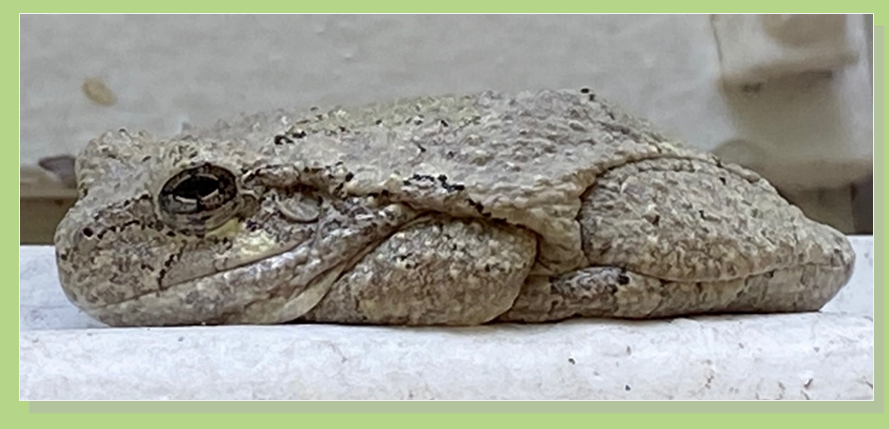
VIEW ON NATURE: Flying Dragons
By: S. Wendt

As I opened the shudders of our mountain cabin near Skyline drive, I noticed what appeared to be a clump of lichen on the windowsill. But upon closer inspection, the ‘lichen’ turned out to be a chalky grey frog like no other. The frog was in 100% “camouflage mode”, both in in appearance and behavior. Its mottled, powdery skin coloring and pattern looked exactly like lichen on the ashen sill. Its legs were oddly tucked under its cupped, flattened body, as it surprisingly remained completely immobile in its puckered position, even after I gently moved it off the sill! That’s when realized I was looking at the Master of Concealment -- the gray treefrog.
It was unusual to encounter this treetop arboreal species down on earth. These mostly solitary, nocturnal creatures commonly found in forests seldom venture down from the tree canopies other than for breeding or occasional meals of insects near porch lights and windows. They mostly forage on moth, butterfly and beetle larvae amongst the treetop foliage, and easily traverse any surface with their highly adaptable suction cups toes.
An impressive trait is their ability to camouflage themselves by varying their skin color across a broad palette ranging from white to gray, tan, green, brown, and nearly black. They can change their color like chameleons, but at a slower rate, disguising themselves according to their ambient surroundings, temperature, and lighting. No wonder its scientific name is Hyla versicolor, which translates from Latin to “belonging to the woods” and “various colors”.
Besides their impressive concealment, gray treefrogs protect themselves in other ways. They produce a noxious skin secretion that can cause discomfort to the eyes, lips, nasal lining, and open cuts of predators. They also avoid danger by feigning death when approached or captured.
Another very impressive trait is how this frog survives cold winters. Most frogs and toads burrow sufficiently beneath the ground whereas gray treefrogs hibernate in tree or forest floor leaf litter. But this little frog is a hardy one with a survival secret, enabling it to survive freezing temperatures down to 18 °F. As autumn cools, the treefrog begins to generate a glycerol-type substance, a natural “anti-freeze” that protects the cells from bursting when the frog partially freezes.
The gray treefrog is common throughout eastern US and Canada and lives up to 9 years. It is one of 28 species of frogs and toads in Virginia and 2,000 species worldwide. Frogs and toads are the most at-risk group in the world, with 50% threatened by habitat loss, pesticides, herbicides, disease, and poaching. They are excellent indicators of environmental health and water quality, and provide free pest control and nightly serenades. For these reasons I only apply the bare minimum of lawn treatments, and never hire any of those ‘mosquito control’ foggers who are really causing insect, frog and toad apocalypse.
As a kid in Annandale, I could catch toads any night of the week; now you’re lucky to have one in your yard. So to help our Master of Concealment and his kin, consider applying less lawn treatments; installing a simple, inexpensive water feature; and visiting the many informative Virginia frog/ toad conservation web sites (e.g., the Virginia Dept. of Game and Inland Fisheries).
This story can be read in full along with other VIEW ON NATURE stories in the ENDEAVOR News Magazine at www.annandalechamber.com/theendeavornewsmagazine.rhtml
(Copyright © 2012 Annandale Chamber of Commerce. All rights reserved. (Photographs & images, on this page, and on this website, are not available for use by other publications, blogs, individuals, websites, or social media sites.)
Copyright 2012 Annandale Chamber of Commerce. All rights reserved. Privacy Policy

